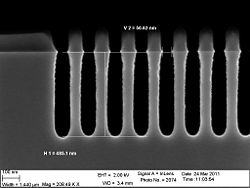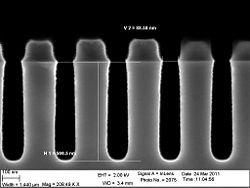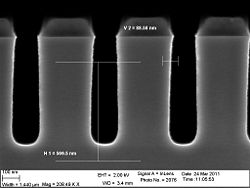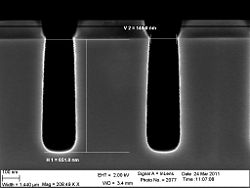Specific Process Knowledge/Etch/DRIE-Pegasus/nanoetch/nano12: Difference between revisions
Appearance
| Line 31: | Line 31: | ||
|- | |- | ||
| Mask | | Mask | ||
| | | 343 nm zep etched down to 154 nm | ||
|- | |- | ||
|} | |} | ||
| Line 44: | Line 44: | ||
C4F8 52 sccm, SF6 38 sccm, 4 mTorr, Strike 3 secs @ 15 mTorr, 800 W CP, 50 W PP, -10 degs, 120 secs | C4F8 52 sccm, SF6 38 sccm, 4 mTorr, Strike 3 secs @ 15 mTorr, 800 W CP, 50 W PP, -10 degs, 120 secs | ||
</gallery> | </gallery> | ||
== Comments == | == Comments == | ||
Lower temperature certainly looks like a step in the right direction. Confirms that the process was too etch aggressive previously, hence the isotropic profiles. | Lower temperature certainly looks like a step in the right direction. Confirms that the process was too etch aggressive previously, hence the isotropic profiles. | ||
Revision as of 14:23, 4 May 2011
The nano1.2 recipe
| Recipe | Gas | C4F8 38 sccm, SF6 52 sccm |
|---|---|---|
| Pressure | 4 mTorr, Strike 3 secs @ 15 mTorr | |
| Power | 800 W CP, 50 W PP | |
| Temperature | -10 degs | |
| Hardware | 100 mm Spacers | |
| Time | 120 secs | |
| Conditions | Run ID | 1817 |
| Conditioning | Sequence: Oxygen clean, MU tests, processes, no oxygen between runs | |
| Mask | 343 nm zep etched down to 154 nm |
- The results of the nano1.2 recipe
-
The 30 nm trenches
-
The 60 nm trenches
-
The 90 nm trenches
-
The 120 nm trenches
-
The 150 nm trenches
Comments
Lower temperature certainly looks like a step in the right direction. Confirms that the process was too etch aggressive previously, hence the isotropic profiles.





